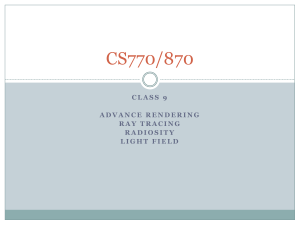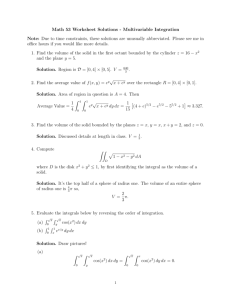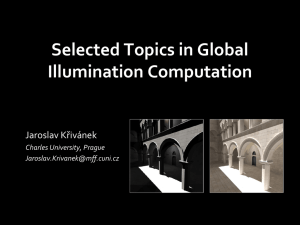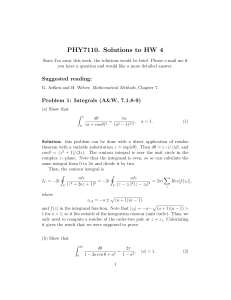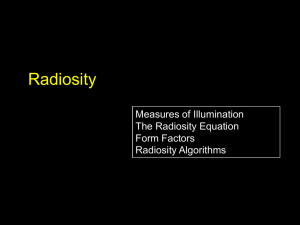PPT
advertisement
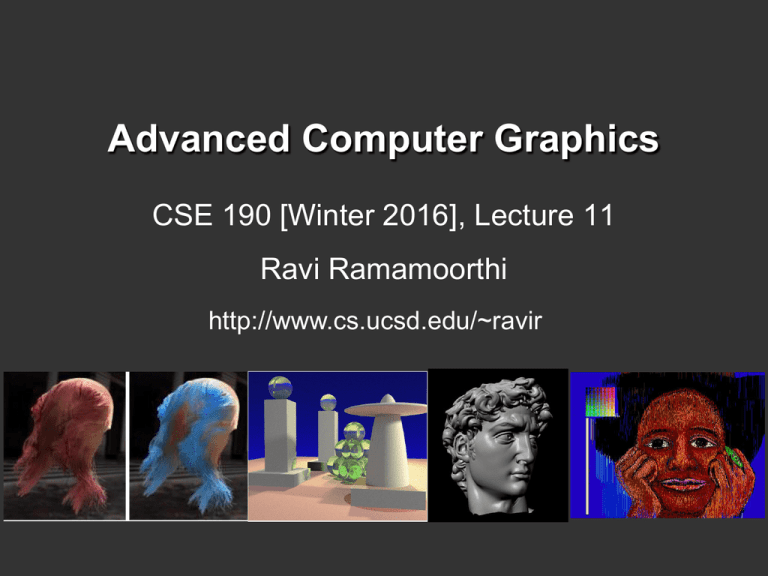
Advanced Computer Graphics CSE 190 [Winter 2016], Lecture 11 Ravi Ramamoorthi http://www.cs.ucsd.edu/~ravir To Do Assignment 2 due Feb 19 Should already be well on way. Contact us for difficulties etc. This lecture on rendering, rendering equation. Pretty advanced theoretical material. Don’t worry if a bit lost; not directly required on the homeworks. Course Outline 3D Graphics Pipeline Modeling (Creating 3D Geometry) Rendering (Creating, shading images from geometry, lighting, materials) Course Outline 3D Graphics Pipeline Modeling (Creating 3D Geometry) Rendering (Creating, shading images from geometry, lighting, materials) Unit 1: Foundations of Signal and Image Processing Understanding the way 2D images are formed and displayed, the important concepts and algorithms, and to build an image processing utility like Photoshop Weeks 1 – 3. Assignment 1 Unit 2: Meshes, Modeling Weeks 3 – 5. Assignment 2 Unit 3: Advanced Rendering Weeks 6 – 7, 8-9. (Final Project) Unit 4: Animation, Imaging Weeks 7-8, 9-10. (Final Project) Illumination Models Local Illumination Light directly from light sources to surface No shadows (cast shadows are a global effect) Global Illumination: multiple bounces (indirect light) Hard and soft shadows Reflections/refractions (already seen in ray tracing) Diffuse and glossy interreflections (radiosity, caustics) Some images courtesy Henrik Wann Jensen Diffuse Interreflection Diffuse interreflection, color bleeding [Cornell Box] Radiosity Caustics Caustics: Focusing through specular surface Major research effort in 80s, 90s till today Overview of lecture Theory for all global illumination methods (ray tracing, path tracing, radiosity) We derive Rendering Equation [Kajiya 86] Major theoretical development in field Unifying framework for all global illumination Discuss existing approaches as special cases Fairly theoretical lecture (but important). Not well covered in textbooks (though see Eric Veach’s thesis). See reading if you are interested. Outline Reflectance Equation (review) Global Illumination Rendering Equation As a general Integral Equation and Operator Approximations (Ray Tracing, Radiosity) Surface Parameterization (Standard Form) Reflection Equation w i r x Lr (x,w r ) = Le (x,w r ) + Li (x,w i )f (x,w i ,w r )(w i in) Reflected Light (Output Image) Emission BRDF Incident Light (from light source) Cosine of Incident angle Reflection Equation w i r x Sum over all light sources Lr (x,w r ) = Le (x,w r ) + å Li (x,w i )f (x,w i ,w r )(w i in) Reflected Light (Output Image) Emission BRDF Incident Light (from light source) Cosine of Incident angle Reflection Equation w i r di x Replace sum with integral Lr ( x,r ) Le ( x,r ) Li ( x,i )f ( x,i ,r ) cosi di Reflected Light (Output Image) Emission BRDF Incident Light (from light source) Cosine of Incident angle Environment Maps Light as a function of direction, from entire environment Captured by photographing a chrome steel or mirror sphere Accurate only for one point, but distant lighting same at other scene locations (typically use only one env. map) Blinn and Newell 1976, Miller and Hoffman, 1984 Later, Greene 86, Cabral et al. 87 Environment Maps Environment maps widely used as lighting representation Many modern methods deal with offline and real-time rendering with environment maps Image-based complex lighting + complex BRDFs The Challenge Lr ( x,r ) Le ( x,r ) Li ( x,i )f ( x,i ,r ) cosi di Computing reflectance equation requires knowing the incoming radiance from surfaces But determining incoming radiance requires knowing the reflected radiance from surfaces Rendering Equation Surfaces (interreflection) x¢ dA w i r d i x Lr (x,w r ) = Le (x,w r ) + ò Lr ( x¢,-w i )f (x,w i ,w r ) cosq i dw i W Reflected Light (Output Image) Emission UNKNOWN KNOWN BRDF Reflected Light UNKNOWN KNOWN Cosine of Incident angle KNOWN Rendering Equation (Kajiya 86) Rendering Equation as Integral Equation Lr (x,w r ) = Le (x,w r ) + ò Lr ( x¢,-w i ) f (x,w i ,w r ) cosq i dw i W Reflected Light (Output Image) Emission UNKNOWN KNOWN BRDF Reflected Light UNKNOWN KNOWN Cosine of Incident angle KNOWN Is a Fredholm Integral Equation of second kind [extensively studied numerically] with canonical form l(u) = e(u) + ò l(v) K(u,v)dv Kernel of equation Linear Operator Equation l (u ) e(u ) l (v) K (u, v)dv Kernel of equation Light Transport Operator L = E + KL Can be discretized to a simple matrix equation [or system of simultaneous linear equations] (L, E are vectors, K is the light transport matrix) Ray Tracing and extensions General class numerical Monte Carlo methods Approximate set of all paths of light in scene L = E + KL IL - KL = E (I - K)L = E -1 L = (I - K) E Binomial Theorem L = (I + K + K + K + ...)E 2 3 L = E + KE + K E + K E + ... 2 3 Ray Tracing 2 L = E + KE + K E + K E + ... 3 Emission directly From light sources Direct Illumination on surfaces Global Illumination (One bounce indirect) [Mirrors, Refraction] (Two bounce indirect) [Caustics etc] Ray Tracing 2 L = E + KE + K E + K E + ... 3 Emission directly From light sources Direct Illumination on surfaces OpenGL Shading Global Illumination (One bounce indirect) [Mirrors, Refraction] (Two bounce indirect) [Caustics etc] Outline Reflectance Equation (review) Global Illumination Rendering Equation As a general Integral Equation and Operator Approximations (Ray Tracing, Radiosity) Surface Parameterization (Standard Form) Rendering Equation as Integral Equation L ( x, ) L ( x, ) L ( x, ) f ( x, , ) cos d r r e r r i i r i i Reflected Light (Output Image) Emission UNKNOWN KNOWN BRDF Reflected Light UNKNOWN KNOWN Cosine of Incident angle KNOWN Is a Fredholm Integral Equation of second kind [extensively studied numerically] with canonical form l (u ) e(u ) l (v ) K (u,v )dv Kernel of equation Linear Operator Theory • Linear operators act on functions like matrices act on vectors or discrete representations h(u) M f (u) M is a linear operator. f and h are functions of u • Basic linearity relations hold a and b are scalars M af bg a M f and g are functions f bM g • Examples include integration and differentiation K f (u ) k (u, v) f (v) dv f D f (u ) (u ) u Linear Operator Equation l (u ) e(u ) l (v ) K (u,v )dv Kernel of equation Light Transport Operator L E KL Can also be discretized to simple matrix equation [or system of simultaneous linear equations] (L, E are vectors, K is the light transport matrix) Solving the Rendering Equation L E KL IL KL E (I K )L E 1 L (I K ) E Binomial Theorem L ( I K K K ...) E 2 3 L E KE K E K E ... 2 3 Term n corresponds to n bounces of light Solving the Rendering Equation • Too hard for analytic solution, numerical methods • Approximations, that compute different terms, accuracies of the rendering equation • Two basic approaches are ray tracing, radiosity. More formally, Monte Carlo and Finite Element • Monte Carlo techniques sample light paths, form statistical estimate (example, path tracing) • Finite Element methods discretize to matrix equation Ray Tracing L E KE K E K E ... 2 3 Emission directly From light sources Direct Illumination on surfaces Global Illumination (One bounce indirect) [Mirrors, Refraction] (Two bounce indirect) [Caustics etc] Ray Tracing L E KE K E K E ... 2 3 Emission directly From light sources OpenGL Shading Direct Illumination on surfaces Global Illumination (One bounce indirect) [Mirrors, Refraction] (Two bounce indirect) [Caustics etc] Outline Reflectance Equation (review) Global Illumination Rendering Equation As a general Integral Equation and Operator Approximations (Ray Tracing, Radiosity) Surface Parameterization (Standard Form) Rendering Equation Surfaces (interreflection) x dA i r d i x i x x Lr ( x,r ) Le ( x,r ) Lr ( x, i )f ( x,i ,r ) cosi di Reflected Light (Output Image) Emission UNKNOWN KNOWN BRDF Reflected Light UNKNOWN KNOWN Cosine of Incident angle KNOWN Change of Variables Lr ( x,r ) Le ( x,r ) Lr ( x , i )f ( x,i ,r ) cosi di Integral over angles sometimes insufficient. Write integral in terms of surface radiance only (change of variables) o i x i i d i x dA dA cos o d i | x x |2 Change of Variables Lr ( x,r ) Le ( x,r ) Lr ( x , i )f ( x,i ,r ) cosi di Integral over angles sometimes insufficient. Write integral in terms of surface radiance only (change of variables) Lr ( x,r ) Le ( x,r ) all x visible to x cos i coso Lr ( x , i )f ( x,i ,r ) dA 2 | x x | dA cos o d i | x x |2 G( x, x) G( x, x) cos i cos o | x x |2 Rendering Equation: Standard Form Lr ( x,r ) Le ( x,r ) Lr ( x , i )f ( x,i ,r ) cosi di Integral over angles sometimes insufficient. Write integral in terms of surface radiance only (change of variables) Lr ( x,r ) Le ( x,r ) all x visible to x cos i coso Lr ( x , i )f ( x,i ,r ) dA 2 | x x | Domain integral awkward. Introduce binary visibility fn V Lr ( x,r ) Le ( x,r ) Lr ( x , i )f ( x,i ,r )G( x, x )V ( x, x ) dA all surfaces x Same as equation 2.52 Cohen Wallace. It swaps primed And unprimed, omits angular args of BRDF, - sign. Same as equation above 19.3 in Shirley, except he has no emission, slightly diff. notation dA cos o d i | x x |2 G( x, x ) G( x, x) cos i cos o | x x |2 Radiosity Equation Lr ( x,r ) Le ( x,r ) Lr ( x , i )f ( x,i ,r )G( x, x )V ( x, x ) dA all surfaces x Drop angular dependence (diffuse Lambertian surfaces) Lr ( x ) Le ( x ) f ( x ) Lr ( x )G( x, x )V ( x, x ) dA S Change variables to radiosity (B) and albedo (ρ) B( x ) E( x ) ( x ) B( x ) G( x, x )V ( x, x ) dA Expresses conservation of light energy at all points in space S Same as equation 2.54 in Cohen Wallace handout (read sec 2.6.3) Ignore factors of π which can be absorbed. Discretization and Form Factors B( x ) E( x ) ( x ) B( x ) G( x, x )V ( x, x ) S Bi = Ei + ri å B j Fj®i j dA Aj Ai F is the form factor. It is dimensionless and is the fraction of energy leaving the entirety of patch j (multiply by area of j to get total energy) that arrives anywhere in the entirety of patch i (divide by area of i to get energy per unit area or radiosity). Form Factors j Aj r i Ai dAi Ai Fi j Aj Fj i dA j G( x, x )V ( x, x ) dAi dAj G( x, x ) G( x , x ) cos i cos o | x x |2 Matrix Equation Bi = Ei + ri å B j Fj®i Aj j Ai Fi j Aj Fj i Ai G( x, x )V ( x, x ) dAi dAj Bi = Ei + ri å B j Fi® j Bi - ri å B j Fi® j = Ei j j åM B j ij j = Ei MB = E Mij = Iij - ri Fi® j Summary Theory for all global illumination methods (ray tracing, path tracing, radiosity) We derive Rendering Equation [Kajiya 86] Major theoretical development in field Unifying framework for all global illumination Discuss existing approaches as special cases

